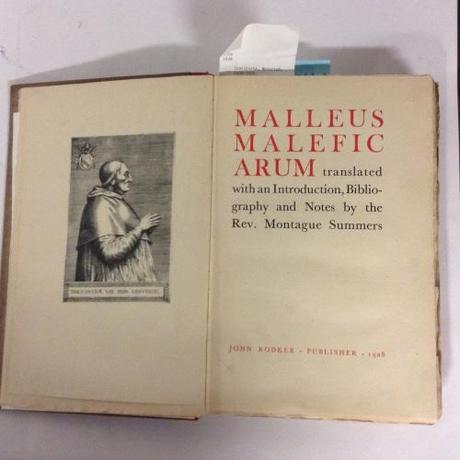Contributed by Devan Murphy.
Devan has worked as a student assistant at the CHP since 2012. She mainly works with the manuscript collections. She is a junior at UA, majoring in English and minoring in French, drawing, and illustration.
Innocuously perched on a shelf in CHP’s library among the multitude of volumes of psychology and philosophy texts sits Malleus Maleficarum, a 1480s treatise promoting the awareness of witches as well as the knowledge of how they may be withstood and punished. First published in Latin by Henry Kramer and James Sprenger at the apex of the witch-hunting era, CHP’s Malleus Maleficarum is one of 1275 numbered copies of the premier English edition (1928), translated and introduced by Reverend Montague Summers.


The book is prefaced by the Bull of Innocent VIII – a charter issued by Pope Innocent VIII in 1484 in support of an investigation of magic and its evils. Following this is Kramer and Sprenger’s delineation, in three parts, of the characteristics and actions of witches, in addition to the steps for properly identifying, defeating, and punishing them.
Part one is titled “Treating of the three necessary concomitants of witchcraft which are the devil, a witch, and the permission of almighty God” and includes such chapters as “Whether the Belief that there are such Beings as Witches is so Essential a Part of the Catholic Faith that Obstinacy to maintain the Opposite Opinion manifestly savours of Heresy” and “Whether Witches can by some Glamour Change Men into Beasts”.
Part two, “Treating of the methods by which the works of witchcraft are wrought and directed, and how they may be successfully annulled and dissolved” (including such chapters as “How they are Transported from Place to Place” and “Remedies prescribed against Hailstorms, and for Animals that are Bewitched”).
Part three, “Relating to the judicial proceedings in both the ecclesiastical and civil courts against witches and indeed all heretics” (including such chapters as “Who are the Fit and Proper Judges in the Trial of Witches?” and “Of the Manner of Pronouncing a Sentence which is Final and Definitive”).

Summers closes his introduction with the confidence that, as Kramer and Sprenger’s treatise “deals with eternal things, the eternal conflict of good and evil,” it therefore “must eternally capture the attention of all men who think, all who see, or are endeavoring to see, reality beyond the accidents of matter, time, and space” (xl). The witch-hunting zeitgeist may be past, and though the validity of Malleus Maleficarum’s subject matter is, in our era, generally refuted, there is yet no doubt that witchcraft and magic in general represent an ageless cultural interest that makes this book relevant in any time period. Besides this, Kramer and Sprenger’s work offers insight into the medieval mindset. Malleus Maleficarum is a must-read for anyone intrigued by religion, history, or the supernatural.
